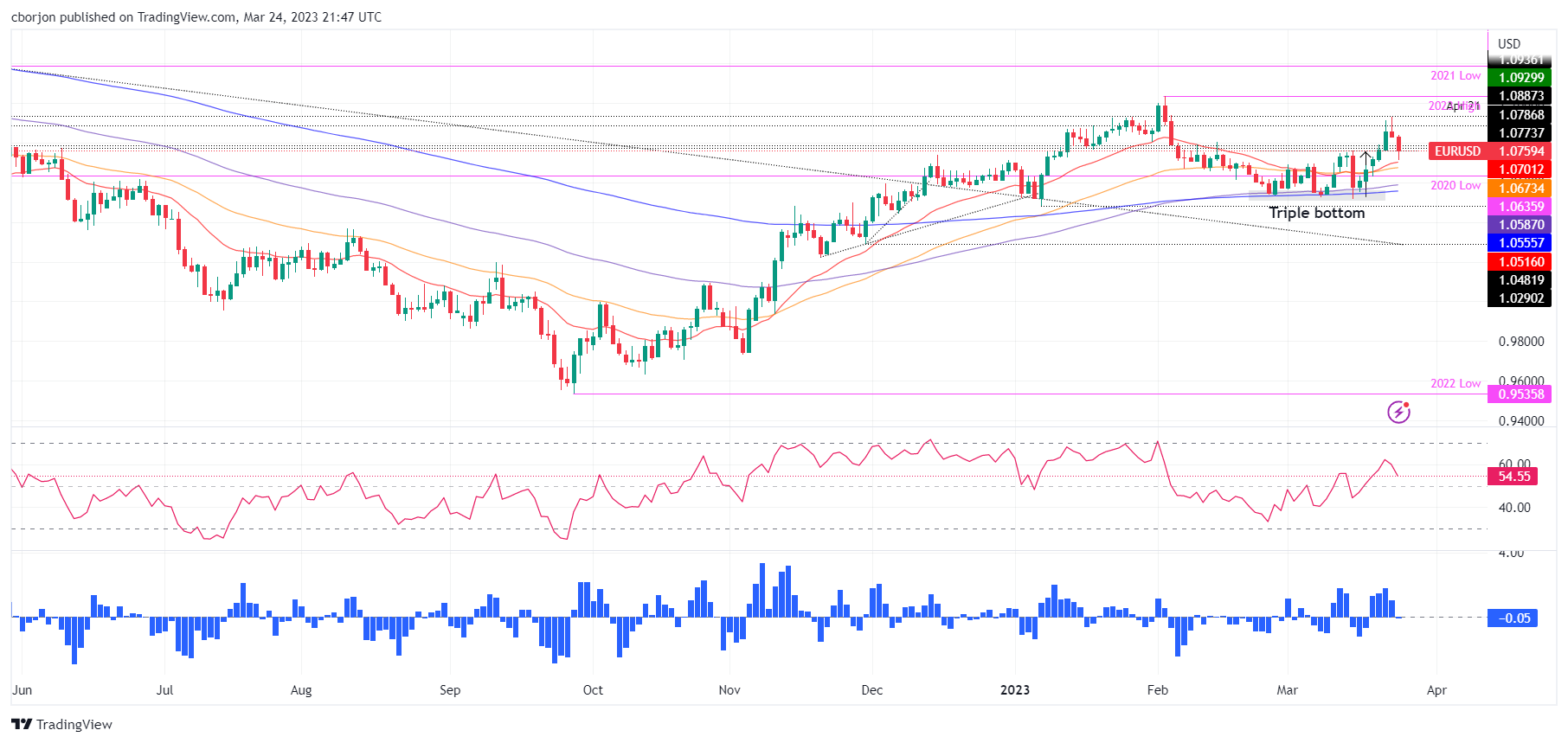EUR/USD Edges Lower And Tests 1.0750 Support As A Triple Bottom Stays In Play

Image Source: Pexels
- The EUR/USD pair had set out to finish the week with decent gains of 0.89%.
- US economic data was mixed, though it portrays a deceleration of the economy.
- ECB policymakers remain focused on tackling high inflation levels in the Eurozone.
As the week's trading came to a close, the EUR/USD currency pair fell 0.64% or 69 pips. The presence of a risk-on impulse did not help the euro, which weakened the shared currency, as it was additionally placed under pressure by the banking crisis and the possibility of its spread into the Eurozone. The EUR/USD pair has recently been seen trading at around 1.0759.
EUR/USD Drops on US Dollar Strength, Weak EU PMIs
Despite experiencing another bout of turbulence, the US equities market was poised to finish the week positively. Deutsche Bank’s stock experienced a sharp decline over the week due to concerns over the potential of a default, which was reflected in a 220 basis point increase in Credit Default Swaps (CDS).
Although this had harmed Wall Street at the beginning of the recent trading session, investors appeared to dismiss these fears and instead speculated that the Federal Reserve (Fed) would lower interest rates in 2023.
St. Louis Fed President James Bullard expressed that rates should be raised further to reach the 5.50-5.75% range, which would mean an additional 75 bps of rate hikes on top of the Fed’s recent increase of 4.75-5.00%. Meanwhile, Atlanta Fed President Raphael Bostic commented that the decision made in March was not easy, as there was much debate to contend with.
Thomas Barkin, the President of the Richmond Federal Reserve, stated that he felt the banking sector was very stable when they arrived at the meeting. Therefore, the conditions were suitable for implementing monetary policy as intended.
The S&P Global PMI showed improvement in March, surpassing both expectations and the data from the previous month. Although the Manufacturing Index remained in a state of contraction, durable good orders saw a 1% drop, which was still an improvement compared to the reading from the previous month.
In the Eurozone, March’s S&P Global PMIs were positive, except for the Manufacturing component, which remained in recessionary territory. European Central Bank (ECB) policymakers crossed news wires, led by the ECB’s President Christine Lagarde, saying there’s no trade-off between price and financial stability.
Bundesbank President Joachim Nagel commented that a pause is not in order as inflation, seen averaging around 6% in Germany, the Eurozone’s biggest economy, will take too long to come back to the ECB’s 2% target.“Wage developments are likely to prolong the prevailing period of high inflation rates,” Nagel said in Edinburgh. “In other words: Inflation will become more persistent.”
EUR/USD Technical Analysis
The EUR/USD currency pair failed to hold to its previous gains, though the triple bottom chart pattern remains in play as long as it stays above the 1.0759 level. A breach of the latter would invalidate the pattern, and open the door for further losses. On the upside, the first resistance would be seen at 1.0800, followed by the 1.0900 figure, ahead of the year-to-date high at 1.1032.
EUR/USD

More By This Author:
GBP/USD Corrects Further From Multi-Week High, Drops Closer To 1.2200 On Weaker UK PMIsGold Price Forecast: Dovish Fed Hike Spurs Recovery In XAU/USD
Silver Price Analysis: XAG/USD Retraces Toward $22.20s On Upbeat Mood, Dragonfly Doji Surfaces
Disclaimer: Information on these pages contains forward-looking statements that involve risks and uncertainties. Markets and instruments profiled on this page are for informational purposes only ...
more



